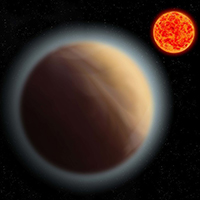Astronomers detect atmosphere around Earth-like planet
April 6, 2017

Artist’s impression of atmosphere around super-Earth planet GJ 1132b (credit: MPIA)
Astronomers have detected an atmosphere around an Earth-like planet beyond our solar system for the first time: the super-Earth planet GJ 1132b in the Southern constellation Vela, at a distance of 39 light-years from Earth.
The team, led by Keele University’s John Southworth, PhD, used the 2.2 m ESO/MPG telescope in Chile to take images of the planet’s host star GJ 1132. The astronomers made the detection by measuring the slight decrease in brightness, finding that its atmosphere absorbed some of the starlight while transiting (passing in front of) the host star. Previous detections of exoplanet atmospheres all involved gas giants reminiscent of a high-temperature Jupiter.
Possible “water world”
“With this research, we have taken the first tentative step into studying the atmospheres of smaller, Earth-like, planets,” said Southworth. “We simulated a range of possible atmospheres for this planet, finding that those rich in water and/or methane would explain the observations of GJ 1132b. The planet is significantly hotter and a bit larger than Earth, so one possibility is that it is a ‘water world’ with an atmosphere of hot steam.”
Very low-mass stars are extremely common (much more so than Sun-like stars), and are known to host lots of small planets. But they also show a lot of magnetic activity, causing high levels of X-rays and ultraviolet light to be produced, which might completely evaporate the planets’ atmospheres. The properties of GJ 1132b show that an atmosphere can endure for a billion years without being destroyed, the astronomers say.
Given the huge number of very low-mass stars and planets, this could mean the conditions suitable for life are common in the Universe, the astronomers suggest.
The discovery, reported March 31 in Astronomical Journal, makes GJ 1132b one of the highest-priority targets for further study by current top facilities, such as the Hubble Space Telescope and ESO’s Very Large Telescope, as well as the James Webb Space Telescope, slated for launch in 2018.
The team also included astronomers at Luigi Mancini Max Planck Institute for Astronomy (MPIA), University of Rome, University of Cambridge, and Stockholm University.